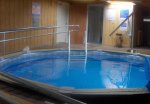Bruce,
In situations with a high CH, one can intentionally lower the Total Alkalinity (TA) to try and compensate somewhat. This also helps keep the rate of pH rise lower since that is mostly a function of TA level (due to carbon dioxide outgassing). Finally, the use of 50 ppm Borates should significantly reduce the amount of scaling in the SWCG because it strongly buffers against a rise in pH.
For example, without 50 ppm Borates and assuming a TA of 80 ppm, CYA of 80 ppm, then a pure base (such as produced at the hydrogen gas generation plate) that would raise the pH from 7.5 to 8.8 without borates would only raise it to 7.9.
Richard
In situations with a high CH, one can intentionally lower the Total Alkalinity (TA) to try and compensate somewhat. This also helps keep the rate of pH rise lower since that is mostly a function of TA level (due to carbon dioxide outgassing). Finally, the use of 50 ppm Borates should significantly reduce the amount of scaling in the SWCG because it strongly buffers against a rise in pH.
For example, without 50 ppm Borates and assuming a TA of 80 ppm, CYA of 80 ppm, then a pure base (such as produced at the hydrogen gas generation plate) that would raise the pH from 7.5 to 8.8 without borates would only raise it to 7.9.
Richard





